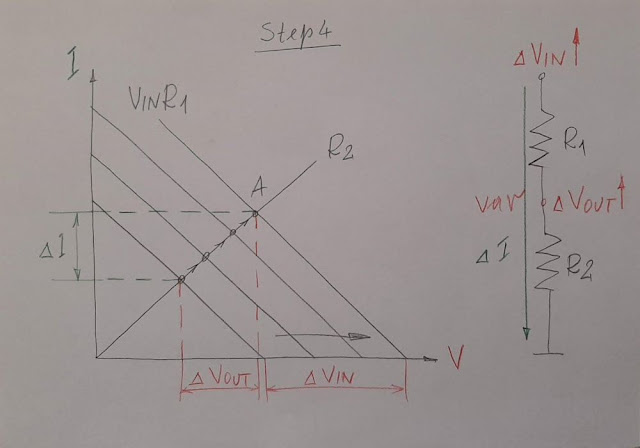What Is the Operating Point?
By the mid-1990s, I had already developed my own philosophy about electronic circuits, and I decided it was time to share it with my colleagues. In the spring of 1997, I presented a series of three papers at the XXXII Scientific Conference on Communication, Electronic and Computer Systems at the Technical University of Sofia. The third of these (in Bulgarian) was dedicated to my idea of visualizing circuit operation through interactive superimposed curves. In this post I will tell you about this venture of mine.
Need to Visualize the Operating Point
In addition to voltage bars, voltage diagrams, and current loops, we can also visualize circuit operation with superimposed IV curves. The idea of this graphic representation is as follows.
The Idea
By means of equivalent transformations, we can reduce any electrical circuit to two 2-terminal parts - a source and a load. Each of them is represented graphically with its IV curve, which represents all possible pairs of the voltage V across and the current I through the part. At a certain moment in time, however, only one of the possible pairs (V,I) acts and it determines the position of only one point A from the graph - the operating point of the circuit. Since the voltage and current are the same for both elements, the operating point is obtained from the intersection of their IV curves drawn in a common coordinate system. The IV curve of the element connected to ground starts at the origin of the coordinate system and is sloped to the right; the IV curve of the other element is offset to the right and sloped to the left. This representation allows to illustrate the operating mode (point) of the circuit.
Voltage-to-current converter (resistor) driven by a voltage source. The simplest example that we can graphically represent in this way can be the elementary Ohm's circuit consisting only of a resistor driven by a voltage source. Here, the first circuit part consists only of the resistor R connected to ground. Its IV curve is a straight line that passes through the origin of the coordinate system and is inclined to the right. The second part consists only of the voltage source; its IV curve is a vetical line shifted to the right along the abscissa axis with the value of its voltage VIN.
Voltage divider driven by a constant input voltage. Another more complicated example can be a voltage divider made up of resistors R1 and R2 and driven by a constant input voltage VIN - Fig. 2. The first circuit part consists only of the resistor R2 connected to ground. Its IV curve is a straight line that passes through the origin of the coordinate system and is inclined to the right. The second part consists of two elements in series - the resistor R1 and the voltage source VIN (we can think of this network as a real voltage source with voltage VIN and internal resistance R1). Its composite IV curve is a straight line shifted to the right along the abscissa axis with VIN and tilted to the left (we can denote it as VINR1). We superimpose the curves of the two elements; the intersection point A determines the current IA flowing through the voltage divider and its output voltage VA.
Voltage divider driven by a varying input voltage. During the circuit operation, some of the circuit quantities changes its magnitude (for the divider example, it can be the input voltage or one of the resistances). As a result, its IV curve begins to move, and the operating point slides along the other IV curve. Thus, the moving curve scans the stationary one (the moving one is scanning, and the stationary one is scanned). In the voltage divider example, if the source voltage is changed, its IV curve VINR1 moves parallel to itself (performs a translation). If the resistance R1 is changing, its IV curve rotates around the origin of the coordinate system; if the resistance R2 is changing, its IV curve rotates around the point VIN on the abscissa axis.
Sophisticated IV curves
A more complicated example – the classical circuit of an op-amp inverting amplifier, is shown in the figure below in three cases: R1 changes, R2 changes, both change simultaneously and in the same direction. In all three cases, the operational amplifier (until it has reached the supply rails) successfully copes with its main task - to maintain a zero voltage (virtual ground) at its inverting input. For this purpose, it changes its output voltage in the corresponding direction and moves the IV curve of the resistor R2.
"Live" IV curves
We can even make animated circuit tutorials (for example, with Flash animator) with moving IV curves (you need Ruffle Flash emulator to see Flash movies because Adobe Flash player is no longer supported).
See also (this blog)
What are voltages in circuits? (voltage bars with proportional height)
What are voltages inside resistors? (voltage diagram)
Where do currents flow in circuits? (current loops with proportional thickness)
More Web Resources
Wikibooks
How to Visualize Voltages in Circuits (by voltage bars with proportional height)
How to Visualize Voltages inside Resistors (by a voltage diagram)
How to Visualize Currents in Circuits (by current loops with proportional thickness)
How to Visualize Operating Point (by superimposed IV curves)
Codidact
Google Drive
Interactive Graphoanalytic Method for Visualization of Circuit Operation (in Bulgarian, XXXII Scientific Conference on Communication, Electronic and Computer Systems, Technical University of Sofia, May 16, 1997)





Comments
Post a Comment